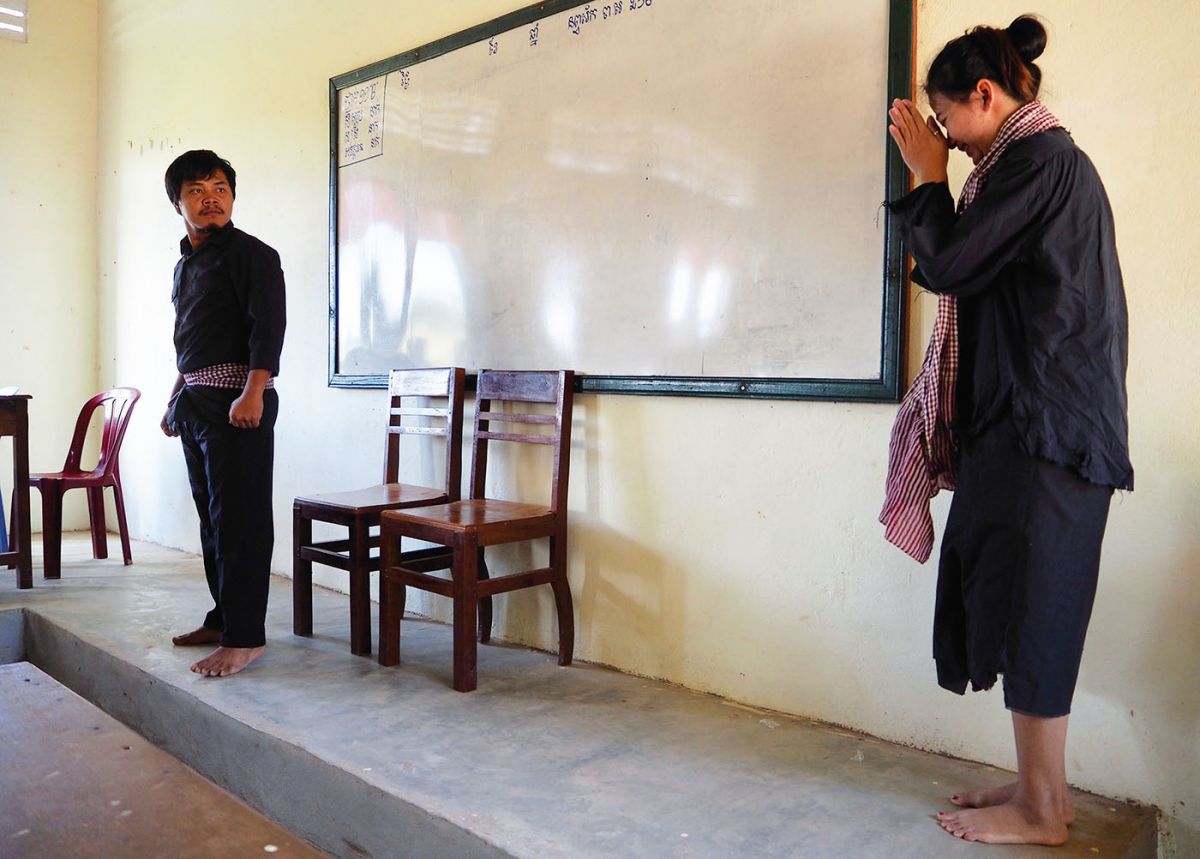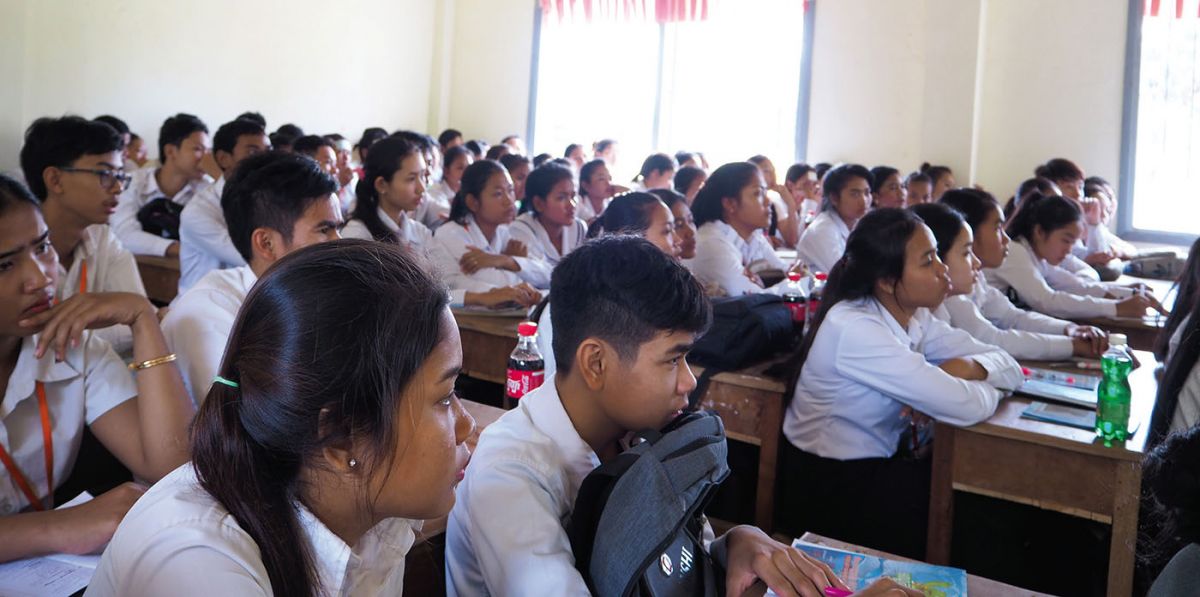Reparations of the Extraordinary Chambers in the Courts of Cambodia: a brief update
Some refer to a ‘cultural renaissance’ as being underway in Cambodia, even as recent events in the political sphere have troubled many. The arts — film, dance, music, theatre, drawing, sculpture and literature – are increasingly prominent mediums for education and intergenerational dialogue in the country, as well as for finding some satisfaction and peace for victim-survivors.
The morning sky is clear and the pale grey cattle pass by the classroom building. Some eighty senior students of Kampong Chhnang High School wait inside for a show to begin. An actor suddenly appears at the door. She is dressed in a school uniform like theirs but carries a drawing in one hand and what appears to be a turtle in another – its head firmly tucked inside its shell. This is a performance of ‘Courageous Turtle’, a two-actor play written by Sokyou Chea and directed by Soung Sopheak that is currently touring Cambodia. One of the suggestions of the play is that we can learn from turtles: “only if you stick your neck out [do] you make progress!”. It uses humour, pathos and audience participation to play out situations of control and resistance, and stories of suffering, care, worry, longing and loss. Relationships from the past and present – between students, family members and cadre – provoke attention to the nature of action, repercussion and courage. The official aim of the play is to promote historical awareness and civil courage in Cambodia by reference to the Khmer Rouge regime. 1
After watching the play, students listen to one or more victim-survivors from their local area speak about living under Khmer Rouge rule. In Kampong Chhnang, many had questions for their elder after she spoke about her experiences. It is estimated that, by the end of 2017, 150 civil parties and over 10,000 students had seen the play and engaged in intergenerational dialogue following the performance. 2
Reparation projects
The Courageous Turtle is one of nearly thirty reparation projects either recognised or currently awaiting recognition by Cambodia’s internationalised Khmer Rouge tribunal. The Extraordinary Chambers in the Courts of Cambodia (ECCC) is a hybrid international criminal tribunal currently underway in Cambodia. It aims to bring those most responsible for crimes committed in Cambodia between 1975 and 1979 to justice. One important development of the Cambodian tribunal is to allow some victim-survivors to directly participate as parties in the cases against former Khmer Rouge. These participating victims are known as civil parties and they assist the Prosecution and may claim for reparations.
ECCC Case 002/01 was completed in 2016, resulting in the conviction of two former senior Khmer Rouge, Khieu Samphan and Noun Chea. As part of this case, some eleven reparations have been implemented, including permanent and mobile exhibitions, the publication and distribution of the case judgement, a memorial, published testimonies and testimonial therapy and curriculum resources.
For Case 002/02, whose closing statements I observed in June 2017, fourteen funded projects are currently being considered by the three Cambodian and two international Trial Chamber judges. Recognition of these projects is expected (as part of the larger judgement) in the third quarter of 2018. These additional fourteen reparations include the play discussed above, as well as a legal archive, dance performance, storybook, graphic novel, song-writing competition, and an internet-enabled app for learning Khmer Rouge history. Most of the reparations are either already completed or well underway; their recognition by the tribunal will be largely retrospective.
All these reparation projects – in their development, resolution and implementation – have involved donors, partner organisations and victims themselves. Many long-standing Cambodian NGOs have helped to develop and implement these projects as partner organisations. As well as involving civil society, two initiatives have been made possible by the Cambodian government, while other government Ministries – especially the Ministry of Education, Youth and Sport – have lent their support to the work of partner organisations on other reparations.
The politics of reparation
In my research, I am interested in how these reparations have come about. Existing relationships and complex negotiations mean that these initiatives are all in some way political. I am also asking: when, where and for whom is this redress? What is the nature of these reparations, what is their spatial and temporal extent? And what is the relationship between these reparations and other past and present-day memory work in Cambodia? How do the current activities and events arise out of, or directly contest, these other ways of working with the past?
Many of the ECCC reparations have been funded by the German state, while three projects share a large pool of European Union funding. This is not a politically neutral arena; rather, memory work is seen as a means to access a new funding stream by both existing and new organisations. As many of these organisations are headed by overseas-born or educated Cambodians who have returned home from the diaspora, the ‘geography of justice’ of the ECCC extends not only inside but beyond Cambodia’s national borders.
Most of the reparations are creative arts-based projects, adding to an increased role of art and art practice in public dialogue about the past in Cambodia. One of the expected effects of the ECCC reparations is greater cross-cultural and intergenerational dialogue at an interpersonal level. New forms of scholarly or larger-scale historical dialogue, and renovation or contestation of prior political cultures of memory, is also observable.
Many reparations are based in, or travelling into, provincial areas, to places otherwise distanced by rural-urban inequality. In many ways, and perhaps not surprisingly, these ‘projects’ are a continuation of memory work, or historical dialogue, that has been ongoing for decades. This memory work was central to building political legitimacy throughout the country in the post-Khmer Rouge period.
Change
Between my visits to Cambodia in June 2017 for the final hearings of Case 002/02 and January 2018, there were a few important changes. One change was increased uncertainty and cynicism amongst Cambodians and civil society actors. Researchers and NGO staff were worried about the viability of their ongoing work, many quietly despairing of political debate. With the arrest and detention of the politician Kem Sohka, and the forced closure of the well-known independent newspaper The Cambodia Daily, many in Cambodia are concerned about the future.
Another change was the relative quiet at the ECCC, with no more Trial Chamber hearings for now. As the judges deliberate Case 002/02, reparation activities continue elsewhere. On tour with the Courageous Turtle, at a new memorial installation site, and in the rooms of the new Legal Documentation Centre, the legacies of the ECCC are only just emerging. In the words of Prim Phloeun, Executive Director of Cambodia Living Arts:
[the process of] finding justice has used the arts [because] you have to recreate and reimagine what was the past and how can we also tell those stories, but in a way that […] is about creating dreams, creating a future, creating something that people can relate to.
Rachel Hughes is a Senior Research Fellow in the School of Geography at the University of Melbourne. Her interests include the politics and geopolitics of the memorialisation of the Khmer Rouge regime, and the social and political legacies of the current Khmer Rouge Tribunal (the Extraordinary Chambers in the Courts of Cambodia). hughesr@unimelb.edu.au

